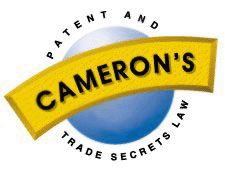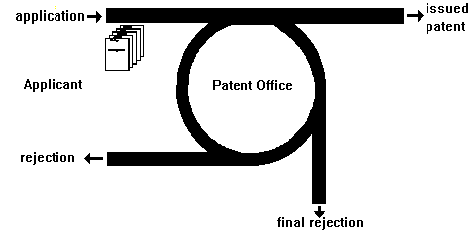
Preparing and Filing a Patent Application
copyright 1997, 1998 Donald M. Cameron, Aird & Berlis
Cameron's Canadian Patent & Trade Secrets Law: Home Page; Index
 |
Preparing and Filing a Patent Application
|
Table of Contents |
|
| Preparing the Application | Filing the Application |
The invention is described and claimed in a patent application, which looks like the patent that the Applicant wishes to have issued.
The patent application is accompanied by documentation requesting the grant of a patent (called the Petition) and evidencing the authority of the person applying for the patent.
In the usual course of things, a patent agent has his or her client help write the patent application by answering questions which give flesh to the "skeleton" of the patent application.
Have the inventor provide answers to the following information:
1. A brief description of the problem which the invention is intended to solve;
2. A brief description of previous approaches to solving the problem;
3. A brief description of the disadvantages and shortcomings of the previous approaches;
4. A brief description of the aspects of the invention which solve the problem and overcome the disadvantages and shortcomings of the previous approaches;
5. A detailed description of the invention, including the operation, construction and use of the invention, with reference to drawings, schematic diagrams, etc.;
6. A brief discussion of other embodiments of the invention.
Since the patent application will be tailored to include as much as possible beyond what exists in the prior art, the Patent Agent must have a good idea of the state of the prior art.
Usually a search is done in the Canadian or U.S. Patent Office to find relevant prior art in the area.
Manual searches can be conducted within Patent Offices or they can be done on computer either from commercial services or free on the Internet:
After the search is done, the Patent Agent gives the client an idea of the scope of protection likely available since the patentability search mimics the search that will be done later by the Examiner of the Patent Office, during the prosecution stage (See below).
Section 27 of the Patent Act sets out the requirements for the disclosure and the claims:
27. (3) The specification of an invention must:
(a) correctly and fully describe the invention and its operation or use as contemplated by the inventor;
(b) set out clearly the various steps in a process, or the method of constructing, making, compounding or using a machine, manufacture or composition of matter, in such full, clear, concise and exact terms as to enable any person skilled in the art or science to which it pertains, or with which it is most closely connected, to make, construct, compound or use it;
(c) in the case of a machine, explain the principle of the machine and the best mode in which the inventor has contemplated the application of that principle; and
(d) in the case of a process, explain the necessary sequence, if any, of the various steps, so as to distinguish the invention from other inventions.
27. (4) The specification must end with a claim or claims defining distinctly and in explicit terms the subject-matter of the invention for which an exclusive privilege or property is claimed.
The patent application itself must meet certain prescribed standards of format [Patent Rules, s. 68 ff]..
A model for the application process is a circular path: the applicant submits the application in the form in which it is desired that the patent be issued; the application is examined and compared to the prior art, and the application is either rejected and required to be amended and returned to the applicant, allowed or finally rejected.

For patent applications filed on or after October 1, 1996, in order to obtain a filing date for a patent application (other than a PCT National Phase application), the Patent Office must receive [Patent Rule 93]:
- an indication in English or French that the grant of a Canadian patent is sought.
- the name of the Applicant.
- the address of the Applicant or the Applicant's patent agent
- a document in English or French that appears to describe an invention, and
- the application fee ($150 for a small entity; $300 for a large entity) [Patent Rules, Schedule II, Part I, Item 1].
Note that claims are no longer required, nor a petition.
To file a complete patent application, you need the following [Patent Rules, s. 94(1)]:
1. Documentation requesting the grant of a patent and establishing the identity of the Applicant(s) and that the person filing the application has the authority to do so.
A Petition (Form 3 Schedule I of the Patent Rules) which identifies:
the name of the Applicant
the name(s) and address(es) of of the Inventor(s)
whether the Applicant is a small or large entity.
A request for priority (if applicable) [See Paris Convention]
An appointment of a Representative, where the Applicant does not reside or carry on business in Canada [Patent Act, s. 29(1)].
An appointment of a Patent Agent (if needed) [Patent Rules, s. 20].
An appointment of an Associate Agent (if needed) [Patent Rules, s. 21]
An assignment or other documentation where the applicant is not the inventor, to prove that the Applicant is the legal representative of the Inventor.
A "small entity" declaration, if applicable
2. A specification (including claims, drawings (if referred to in the Description) and an Abstract.
3. The filing fee ($150 for a small entity; $300 for others).
A patent application must be completed (and all the documents must comply with the Rules) within 15 months from its priority or filing date or else it is deemed to have been abandoned [Patent Act, s. 73 and Patent Rules s. 97]. If it goes abandoned, it may be reinstated within 12 months by making a request for reinstatement to the Commissioner, completing the application,and paying the fee set out in Item 7 of Schedule II ($200.00) [Patent Rules, s. 98].
If any of the documents needed for the application do not comply with the Rules, the Patent Office will advise the Applicant of the informality and require the objections to be overcome within 15 months from the date of filing or the priority date. The Applicant will have until the later of three months from the notice and 12 months after the filing to comply [Patent Rules, s. 94(1)) and will have to pay a government fee of $200.00 (Schedule II, item 8).
Return to:
Cameron's Canadian Patent & Trade Secrets Law: Home Page; Index
Cameron's IT Law: Home Page; Index